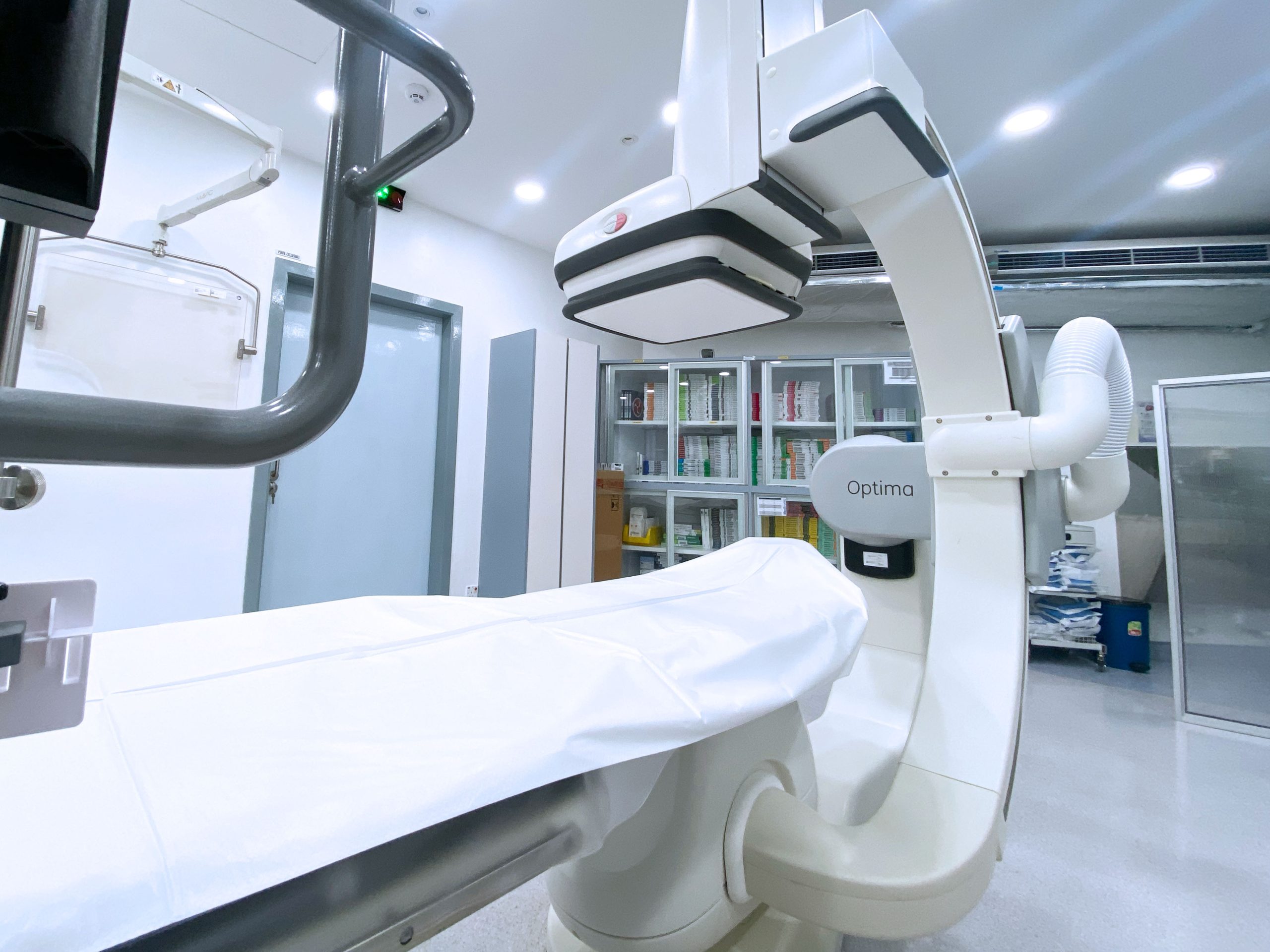
Understanding CT Angiography for Heart Health
CT angiography is a powerful tool for assessing heart health. It offers a non-invasive way to visualize coronary arteries. This procedure is crucial for detecting blockages or narrowing in the arteries.
Understanding the differences between a CT angiogram and traditional angiograms is important. CT angiograms are less invasive and have a quicker recovery time. They provide detailed images of the heart and blood vessels.
This article will explore the benefits, risks, and applications of CT angiography. We will compare it with other diagnostic methods. Our goal is to help you make informed decisions about heart health.
Whether you’re a patient or a healthcare professional, this guide is for you. Let’s dive into the world of CT angiography.
What Is CT Angiography of the Heart?
CT angiography of the heart is a specialized imaging technique. It uses computed tomography to create detailed 3D images of the heart’s arteries. This test helps identify issues like blockages and narrowing in the coronary arteries.
Unlike traditional angiograms, CT angiography is non-invasive. It involves injecting a contrast dye into the bloodstream. This dye highlights the coronary arteries and makes them visible to the CT scanner.
Here are some key aspects of CT angiography for heart health:
- Non-invasive with less risk of complications.
- Provides a quick and comprehensive view of the heart.
- Can detect coronary artery disease early.
CT angiography is especially beneficial for diagnosing coronary artery disease. It’s often used for patients experiencing symptoms like chest pain or shortness of breath. This test can guide further treatment decisions, helping improve patient outcomes.
How Does a CT Angiogram Work?
A CT angiogram is a sophisticated procedure that captures detailed images of the heart. The process begins with a health professional inserting an intravenous (IV) line in the patient’s arm. This line is used to inject a contrast dye that enhances the visibility of the coronary arteries.
Once the dye circulates through the bloodstream, the patient lies on a table. This table then slides into a CT scanner, which resembles a large ring. During the scan, the patient must remain still to ensure clear images.
The CT scanner takes numerous cross-sectional images. These images are then compiled by a computer to create a detailed 3D model of the heart and its blood vessels. Key steps of the process include:
- Injection of contrast dye through an IV line.
- The patient lies still on a moving table.
- A series of images are captured for comprehensive analysis.
After the scan, a radiologist examines the images for signs of abnormalities. This non-invasive test offers vital insights into heart health, often guiding further treatment options.
CT Angiogram vs. Traditional Angiogram: Key Differences
A CT angiogram is less invasive compared to a traditional angiogram. This fundamental difference can affect a patient’s choice when considering heart assessments. While a CT angiogram uses a CT scanner, a traditional angiogram involves inserting a catheter into the arteries.
The CT angiogram does not require extensive recovery time. Patients can resume normal activities shortly after the procedure. Conversely, a traditional angiogram often necessitates a longer recovery period due to its invasive nature.
Exposure to radiation is a consideration in both procedures. However, the radiation dose in a CT angiogram is usually lower than in traditional methods. This factor can be crucial, especially for those who are wary of radiation exposure.
Moreover, the CT angiogram is generally safer, with fewer complications reported. Traditional angiograms can pose risks such as bleeding or infection at the insertion site. Below are some of the distinctions between the two:
- CT angiogram: Non-invasive, quicker recovery, less radiation.
- Traditional angiogram: Invasive, longer recovery, higher risk of complications.
Deciding between the two usually depends on the patient’s condition and the physician’s recommendation. Nevertheless, CT angiograms offer a safe and efficient alternative for many patients.
When Is a CT Angiogram Recommended?
A CT angiogram is often recommended for patients experiencing symptoms like chest pain or shortness of breath. These symptoms may signal potential heart issues needing further exploration. The procedure assists in diagnosing coronary artery disease in cases where traditional methods might be deemed excessive.
Physicians may advise this test for people at low to intermediate risk of heart disease. It provides valuable insight into the condition of the arteries without invasive means. Moreover, it aids in avoiding unnecessary traditional angiograms when the risk is less severe.
Some common situations where CT angiography might be suggested include:
- Evaluation of unexplained chest discomfort.
- Monitoring known cases of coronary artery conditions.
- Checking heart health before or after surgery.
In essence, CT angiography serves as a strategic tool in personalized heart care, tailored to each patient’s unique needs.
Preparing for a CT Angio Heart Procedure
Getting ready for a CT angiogram usually requires some basic steps. Your healthcare provider will instruct you on necessary preparations. It’s crucial to follow these guidelines to ensure accurate results and a smooth procedure.
You might need to fast for a few hours before the test. This fasting reduces the risk of nausea from the contrast dye. Additionally, avoiding caffeine on the day of the procedure can help maintain a steady heart rate.
Other essential preparations may include:
- Reviewing your current medications with your doctor.
- Informing the provider about any allergies.
- Wearing comfortable clothing for the appointment.
Proper preparation helps minimize risks and maximizes the clarity of diagnostic images.
What to Expect During the Procedure
During a CT angiography, you will be asked to lie flat on a scanning table. The technician will place small electrodes on your chest. These are used to monitor your heart rate throughout the scan.
A contrast dye is then injected into a vein, usually in your arm. You may feel a warm sensation as the dye travels through your bloodstream. This dye is crucial for highlighting your blood vessels and heart in the images.
The table moves slowly through a tunnel-like machine called a CT scanner. You need to remain still to ensure clear images. You might be asked to hold your breath for a few seconds during scanning to prevent image blurring.
The procedure typically lasts about 30 minutes. It’s painless and non-invasive, providing detailed visual information about your heart’s condition. After the scan, you’re usually free to go about your day with no immediate recovery needed.
After the CT Angiography: Recovery and Results
Following the CT angiography, recovery is straightforward and quick. Unlike traditional angiograms, you won’t need to rest extensively. You may feel slightly dizzy due to the contrast dye, but this feeling typically subsides quickly.
After the procedure, a doctor will review the images obtained during the scan. This helps diagnose any potential issues. You’ll usually discuss the results and any necessary next steps with your doctor soon after.
Key points from the results might include:
- Presence of artery blockages
- Condition of the heart valves
- Need for further tests or treatments
Overall, the CT angiography provides vital insights into your heart health without the need for invasive interventions.
Benefits of CT Angiography for Heart Health
CT angiography offers numerous benefits for those seeking to monitor their heart health. The procedure is non-invasive and painless, making it less daunting compared to traditional methods. This ease often translates to a quicker recovery time.
Detailed images of the heart and its blood vessels are another advantage. These images allow doctors to detect blockages or other issues early on. Early detection often leads to better treatment outcomes and improved quality of life.
Furthermore, CT angiography can prevent the need for more invasive procedures. A few key benefits include:
- Accurate assessment of coronary artery disease
- Early diagnosis of heart conditions
- Guidance for appropriate treatments
By understanding these benefits, patients can make informed decisions about their heart health journey.
Risks and Limitations of CT Angiography
Like any medical procedure, CT angiography carries certain risks. The use of contrast dye may lead to allergic reactions. Patients with kidney problems should exercise caution since the dye can affect kidney function.
Radiation exposure is another consideration, though lower than traditional angiograms. This makes it unsuitable for pregnant women due to potential harm to the fetus. Discussing the benefits and risks with your doctor is essential.
CT angiography also has its limitations in capturing certain nuances. While it provides excellent imaging, it may miss minor abnormalities. Some scenarios may still require traditional angiography. Key limitations include:
- Not suitable for all patients
- Potential allergic reaction to dye
- May miss small vessel issues
These factors should be considered when evaluating the appropriateness of the procedure.
CT Angiography in Preventive Cardiology
CT angiography plays an essential role in preventive cardiology. By detecting early signs of coronary artery disease, it helps guide treatment and lifestyle changes to halt disease progression. These insights enable timely interventions, often averting severe complications.
The procedure’s detailed imaging offers valuable information for both patients and doctors. It identifies those at risk for heart attacks and other cardiac events. In preventive cardiology, the following benefits stand out:
- Early detection of coronary artery disease
- Personalized treatment strategies
- Monitoring progression or improvement
Through this proactive approach, CT angiography contributes significantly to maintaining heart health and improving long-term outcomes.
Frequently Asked Questions About CT Angio Heart
Many people have questions about CT angiography and its uses. Understanding these aspects can help patients make informed decisions. Here, we address some common queries.
Is CT Angiography Painful?
No, CT angiography is generally painless. Some patients may feel a warm sensation during the contrast dye injection. However, this usually passes quickly.
Can Anyone Have a CT Angiogram?
Not everyone is a candidate for CT angiography. Pregnant women and those with kidney issues should consult their doctors. Your healthcare provider will evaluate if this test is suitable for you.
What Can I Expect from the Results?
The results give detailed insights into your heart health. They help identify blockages or other issues. Based on these results, your doctor can recommend appropriate treatments or lifestyle modifications.
Conclusion: The Role of CT Angiography in Modern Cardiac Care
CT angiography plays a pivotal role in modern cardiac care. It offers a non-invasive and efficient method to assess heart health and detect coronary artery disease. With advancements in technology, CTA continues to provide valuable insights into the heart’s structure and function.
By aiding in the early diagnosis and management of heart conditions, CT angiography enhances patient outcomes. It empowers healthcare providers with detailed information to guide treatment strategies. As a cornerstone of non-invasive diagnostic imaging, CTA is crucial for comprehensive heart health management.

